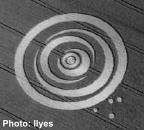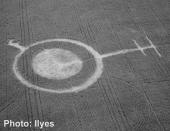|
BLT RESEARCH TEAM INC.
Cambridge, MA (USA)
[www.bltresearch.com] BLT Research Report #0502
MISSION, B.C., CANADA – August/September, 2002
Formation in 9 ft. tall cattle corn (maize) which "evolved" from an original 92 ft. diam. circle w/43 ft. spur to a 284 ft. long pictogram. Many plants observed to be very black, as if burned, at base of stalk. IR spectrum: P.A. Budinger; Photo: L. Konrad


Blackened Corn Stalks
Mission, British Columbia, Canada – 2002
| File Code: |
BLT#0502 |
Event Location: |
Field near Mission, B.C., (East of Vancouver), Canada |
| Date Occurred: |
Mid- to late August, 2002 (?) |
| Date Reported: |
September 8, 2002 |
| Date Sampled: |
October 13, 2002 |
| Material Sampled: |
Corn stalks |
| Sampled By: |
Paul Anderson, Laurel Konrad, CCCRN |
Event Description: One of two maize formations in fields on either side of a highway, which may have occurred at the same time (probably mid-August). The formation sampled here ("Mission #2") "evolved," with additions observed on Sept. 20th and again on Sept. 30th. Sampling was carried out two days after the 2nd addition was reported (Figs. 1, 2, 3). Fieldworkers reported marked blackening of a number of plant stalks at the base (Figs. 4, 5), as well as many stalks bent over at least 2 inches above the ground. [More details on CCCRN web-site: www.cccrn.net ]
Although the formation may have been in the field for 5-6 weeks prior to sampling known (thus increasing the chance that the observed blackening was a common fungus known as Ustilago,) because of the intensity of the black color the question was raised as to whether in this case it might be due to carbonized tissues.
Laboratory Results: Infrared spectroscopy was carried out by analytical chemist, P.A. Budinger, Frontier Analysis, Ltd [full report attached]. The IR spectra of material from the blackened areas of the samples were found to be identical to the IR spectrum of Ustilago fungus (IR spectra, cover page). No carbon was detected.
Discussion: In recent years many Canadian maize formations have shown multiple new plant effects (massive incidence of expulsion cavities-as many as 8-9/stalk- found in all or nearly all downed plants, as well as multiple clean vertical breaks at nodes near the base of the stalks), which may indicate an increase in the intensity of the heating component of the energy system responsible for creating more recent crop circles. These observations, in conjunction with the published evidence (1994; 1995; 1997) that a heating agency (probably microwaves) is responsible for the presence of expulsion cavities found in previous crop formations, motivated the request for this analysis.
Fieldworkers examining maize formations which are more than a week old when found (particularly later on in the season) are very likely to observe a more intense blackening instead of the grey spotting often observed after a few days. The longer the time period which has elapsed since the plants were flattened, the greater the likelihood the Ustilago fungus will become more concentrated. If carbon is present one should be able to detect the smell of charring; and carbon will most likely come off when rubbed, leaving a soot-like substance on the fingers.
Fig. 1: The two maize crop circles (#1 at top, #2 at bottom) at Mission, B.C., Canada, (September 2002). Aerial photo taken after bottom formation (Mission #2) had undergone first addition. Samples of blackened corn stalks were taken from the center of the (Mission #2) circle, a section of the original formation.
Fig. 2: CCCRN diagram showing the Mission #2 formation as it first appeared in late August, then with the first addition on September 20th, and then style as it looked on September 30, 2002.


Fig. 3: Field diagram showing measurements, direction of crop lay and sampling location.

Fig. 4: Photograph taken on January 25, 2003, five months approximately after initial event. Ustilago would have had considerable time to develop, thus creating blackened stems & roots. Photo: Paul Anderson, CCCRN
 Fig. 5
Fig. 5: Laboratory photo of blackened interior of corn stalk. Grey patches on
leaves are also Ustilago, in its more commonly observed (less concentrated) form.

|





